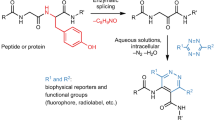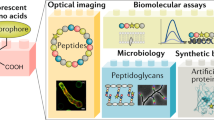Abstract
The introduction of green fluorescent protein and its variants (GFPs) has allowed protein analysis at the level of the cell. Now, chemical methods are needed to label proteins in vivo with a wider variety of functionalities so that mechanistic questions about protein function in the complex cellular environment can be addressed. Here we demonstrate that trimethoprim derivatives can be used to selectively tag Escherichia coli dihydrofolate reductase (eDHFR) fusion proteins in wild-type mammalian cells with minimal background and fast kinetics.
This is a preview of subscription content, access via your institution
Access options
Subscribe to this journal
Receive 12 print issues and online access
$259.00 per year
only $21.58 per issue
Buy this article
- Purchase on Springer Link
- Instant access to full article PDF
Prices may be subject to local taxes which are calculated during checkout



Similar content being viewed by others
References
Zhang, J., Campbell, R.E., Ting, A.Y. & Tsien, R.Y. Nat. Rev. Mol. Cell Biol. 3, 906–918 (2002).
Griffin, B.A., Adams, S.R. & Tsien, R.Y. Science 281, 269–272 (1998).
Johnsson, N. & Johnsson, K. Chembiochem 4, 803–810 (2003).
Keppler, A. et al. Methods 32, 437–444 (2004).
Giriat, I. & Muir, T.W. J. Am. Chem. Soc. 125, 7180–7181 (2003).
Guignet, E.G., Hovius, R. & Vogel, H. Nat. Biotechnol. 22, 440–444 (2004).
Marks, K.M., Braun, P.D. & Nolan, G.P. Proc. Natl. Acad. Sci. USA 101, 9982–9987 (2004).
Miller, L.W., Sable, J., Goelet, P., Sheetz, M.P. & Cornish, V.W. Angew. Chem. Int. Ed. Engl. 43, 1672–1675 (2004).
Roth, B. et al. Med. Chem. 24, 933–941 (1981).
Baccanari, D.P., Daluge, S. & King, R.W. Biochemistry 21, 5068–5075 (1982).
Robson, C., Wright, K.A., Twentyman, P.R., Lambert, P.A. & Griffin, R.J. Biochemical Pharmacology 56, 807–816 (1998).
Remy, I. & Michnick, S.W. Proc. Natl. Acad. Sci. USA 96, 5394–5399 (1999).
Israel, D.I. & Kaufman, R.J. Proc. Natl. Acad. Sci. USA 90, 4290–4294 (1993).
Kalderon, D., Richardson, W.D., Markham, A.F. & Smith, A.E. Nature 311, 33–38 (1984).
Hammond, S.M., Caudy, A.A. & Hannon, G.J. Nat. Rev. Genet. 2, 110–119 (2001).
Jay, D.G. Proc. Natl. Acad. Sci. USA 85, 5454–5458 (1988).
Clackson, T. et al. Proc. Natl. Acad. Sci. USA 95, 10437–10442 (1998).
Acknowledgements
This research was supported by the National Institutes of Health (GM071754-01). V.W.C. is a recipient of a Beckman Young Investigator Award, a Burroughs Wellcome Fund New Investigator Award in the Toxicological Sciences, a Camille and Henry Dreyfus New Faculty Award and a National Science Foundation Career Award.
Author information
Authors and Affiliations
Corresponding author
Ethics declarations
Competing interests
The authors declare no competing financial interests.
Supplementary information
Supplementary Fig. 1
The affinity of TMP-fluorescein for eDHFR was determined by fluorescence polarization. (GIF 33 kb)
Supplementary Fig. 2
Confocal micrographs showing an MEF cell expressing a fusion of puromycin n-acetyl transferase to GFP. (JPG 16 kb)
Supplementary Fig. 3
MEF cells expressing puromycin n-acetyl transferase-eDHFR. (JPG 35 kb)
Rights and permissions
About this article
Cite this article
Miller, L., Cai, Y., Sheetz, M. et al. In vivo protein labeling with trimethoprim conjugates: a flexible chemical tag. Nat Methods 2, 255–257 (2005). https://doi.org/10.1038/nmeth749
Received:
Accepted:
Published:
Issue Date:
DOI: https://doi.org/10.1038/nmeth749
This article is cited by
-
Caveat fluorophore: an insiders’ guide to small-molecule fluorescent labels
Nature Methods (2022)
-
An optochemical tool for light-induced dissociation of adherens junctions to control mechanical coupling between cells
Nature Communications (2020)
-
Molecular conjugation using non-covalent click chemistry
Nature Reviews Chemistry (2019)
-
Graphene based emergent nanolights: a short review on the synthesis, properties and application
Research on Chemical Intermediates (2019)
-
Development of an effective protein-labeling system based on smart fluorogenic probes
JBIC Journal of Biological Inorganic Chemistry (2019)



